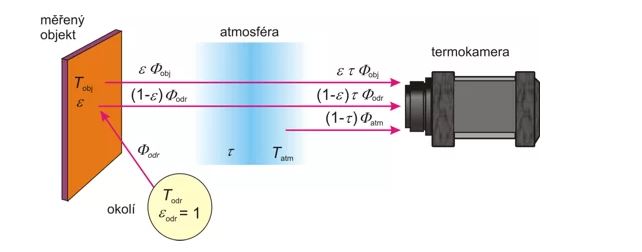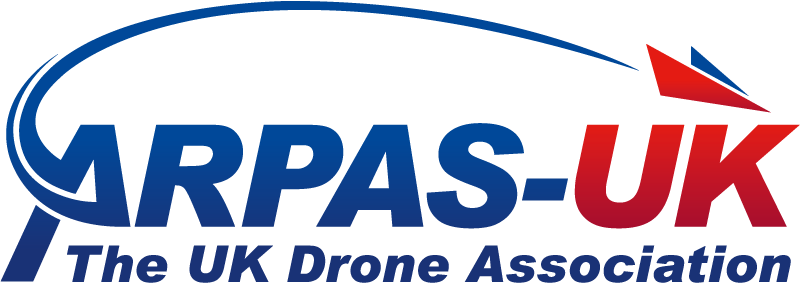Introduction to Thermography
Thermal cameras are devices that are commonly used today for contactless temperature measurement in virtually all industries and scientific and technical research, from heavy metalworking to medical and microbiological research. The thermal camera as a measuring instrument records the intensity of thermal radiation emitted from the surface of the measured objects. Based on the measured radiation intensity and user-specified parameters, the thermal camera can then calculate the surface temperature distribution. This creates a 2D signal – an image in which the individual pixels correspond to the surface temperature (actual or apparent, depending on whether the measurement parameters were entered correctly). This 2D signal, which is the output of the thermal camera measurement, is called a thermogram. The thermogram can be imagined as a digital image, but the individual pixels do not carry information about the measured brightness, but about the surface temperature of the scanned objects.
The technical field that deals with the issue of non-contact temperature measurement and eventually the subsequent use of the obtained data (for example for non-destructive testing) is called thermography. To explain in more detail the issue of non-contact temperature measurement, the physical context of the thermal radiation of the bodies must be explained. Thermal radiation (sometimes also called radiation) is one of the three ways of heat transfer between bodies together with “conduction” and “convection”.
Simple, non-contact temperature measurement is also known as “pyrometer”. They are used for for spot temperature measurement, everything else is virtually unchanged, only the construction is of course made for the purpose. These instruments are currently used extensively in industry, metrology and also in research.
Thermal Radiation
When we expose our body to sunlight, we feel its thermal effects intensely, and even blindfolded, we can quite accurately determine the position of the Sun.
The same feelings are caused by, for example, the radiation of heated stoves. We perceive that the stove’s radiation is as “thermal” as solar radiation. The bodies of all states with a temperature higher than absolute zero emit electromagnetic radiation, which originates in the thermal (thermal) movements of the charged particles of which they are composed. Since the cause of radiation is heat, we call it thermal radiation.
For non-contact temperature measurement, it is important to note that the intensity of radiation from the surface of a body increases with its surface temperature but is dependent on the material properties. The law of physics that describes this is known as Stefan-Boltzmann law, Wien’s displacement law and finally the law from which the two laws are resulted is called Planck’s radiation law. The fact that the intensity of thermal radiation from the surfaces of bodies increases to the fourth power of the surface temperature of the bodies, can be used for non-contact temperature measurement. And it is also used, however in practice the situation is more complicated and it is necessary to know the other measurement parameters and work with the so-called thermography equation, which takes into account the influence of surrounding bodies and the atmosphere.
Determination of Surface Temperature
When working with a thermal camera, it is most important to realize that the thermal camera does not measure temperature directly but according to the so-called thermography equation or according to a simplified relationship determines the measured temperature by calculation based on 1) measured intensity of heat radiation and 2) stated parameters of measurement (some are stated by the so-called supplementary measurements or qualified estimates). To correctly determine the surface temperature of the measured object, the measurement parameters from the thermography equation must be set. Practically it involves:
- emissivity [-] (emissivity of measured surface),
- reflected apparent temperature [° C] (this is thermal radiation reflected from the measured surface),
- atmospheric temperature [°C]
- relative atmospheric humidity [%]; and
- the distance between the measuring instrument and the object’s surface [m].
Thermal imaging cameras, as measuring instruments, always allow emissivity and the reflected apparent temperature to be set. Better thermal cameras (and certainly those for scientific research applications) allow the atmospheric parameters to be set, i.e. atmospheric temperature, relative atmospheric humidityand distance. In addition, some thermal imaging cameras allow external IR windows to be corrected.
The uncertainty of determining individual parameters has a different effect on the resulting measurement uncertainty; it always depends on the situation. For example, the influence of atmospheric parameters is the greater the distance between the thermal camera and the measured object. The effect of the reflected apparent temperature is greater the lower the emissivity, as the reflectivity is greater (and conversely, if the emissivity is close to its maximum value of 1, the effect of the reflected apparent temperature may be practically negligible).
Instead of the correct term “reflected apparent temperature” we can usually find the abbreviated term “reflected temperature” but the exception is not quite other term, such as “background temperature”, “reflected temperature” etc.
Emissivity and Refected Apparent Temperature
Emissivity is a dimensionless parameter characterizing the surface of a measured object in terms of its ability to radiate thermally. It indicates the ratio of the heat flux of the real (grey) body to the heat flux emitted by the black body according to the Stefan-Boltzmann law. In a sense, emissivity is the “radiation efficiency”, the maximum possible value being 1 (for a black body). The higher the emissivity, the more heat radiation the object emits at a given surface temperature. Emissivity is not constant for a given surface and is a function of many other parameters, especially temperature and wavelength. It must be taken into consideration during the measurement.
The reflected apparent temperature characterizes the thermal radiation reflected from the surface of the measured object. In explaining the meaning of the apparent reflected temperature, it is necessary to explain the basic link between emissivity and surface reflectance. For a body with an impermeable surface, the reflectance ρ of the surface is equal ρ = 1− ε, where ε is the emissivity of the surface (all variables should of course be considered as a function of wavelength, temperature, etc.). In practice, this is a very important conclusion because it implies that the lower the emissivity of the surface, the greater the effect of the reflected apparent temperature, which is always annoying with respect to the resulting measurement accuracy. In practice, therefore, it is usually less difficult to measure surfaces with high emissivity and therefore we also try to select the spectral range of the thermal camera so that the emissivity of the measured surface is as large as possible.

The apparent reflected temperature and emissivity can be determined by several methods but this is beyond the scope of this bulletin. In practice, we try to compensate for the effect of the reflected apparent temperature and “subtract” it from the measured values to obtain the true value of the intensity of thermal radiation from the surface of the measured object.
Atmostpheric Parameters
The atmospheric temperature, relative atmospheric humidity, and the distance between the thermal camera and the surface of the measured object are adjusted to correct the effect of the atmosphere. The atmosphere both attenuates thermal radiation from the measured surface (attenuation is then mainly dependent on relative humidity and distance), and is itself a source of thermal radiation (the intensity of thermal radiation of the atmosphere depends mainly on its temperature but also composition). In general, the further away objects are measured, the greater the influence of the atmosphere.
Correction of External Optics
Some thermal cameras can compensate for so-called external optics. By this is meant in particular an infrared window, which can be installed, for example, in a switchboard door and is then used as a viewing window which is partially transparent to infrared radiation. During the thermographic check, the distribution box can remain closed, but the attenuation and radiation of the infrared window through which the measurement takes place must be taken into account. Thermal cameras with this feature allow the temperature and transmittance of the infrared window to be adjusted.
Thermography Equation
The thermography equation relates to all of the above factors: i.e., the radiation that strikes the thermo camera detector is the sum of 1) the radiation emitted by the surface of the measured object (we want to measure this data), 2) the radiation reflected from the surface of the measured object (this radiation comes from surrounding objects and we want to remove it) and 3) thermal radiation coming from the atmosphere, which is between the thermal camera and the measured object (this radiation must also be subtracted from the resulting value). The effect of attenuation of the atmosphere must also be included, which attenuates both the thermal radiation from the surface of the measured object and the thermal radiation of surrounding bodies by this surface into the reflected thermal camera.

The individual components of the radiant flux received by the thermal camera are therefore:
- Radiant flux from the object attenuated by the passage through the atmosphere: ετΦobj (temperature of the object is Tobj).
- Reflected radiant flux from surrounding sources is (1−ε)τ Φodr, where (1−ε) expresses the reflectance of an object. (We assume that radiation from the environment is radiation from surfaces in the imaginary hemisphere that have an emissivity = 1 and the same temperature Todr). The reflected apparent temperature Todr is the apparent temperature of other objects the radiation of which is reflected from the surface of the measured object to the thermal camera.
- Radiant flux emitted by the atmosphere: (1−τ) Φatm , where (1−τ) expresses the emissivity of the atmosphere whose temperature is Tatm.
- Full transparency of thermal camera optics is considered and the radiant flux of optical components is considered negligible.
Now the equation for the total radiant flux that impinges on the thermal camera detector can be stated. This equation is sometimes referred to as the thermal camera measurement equation or also the equation of thermography:
Φcelk = ετΦobj + (1−ε)τ Φodr + (1−τ) Φatm
Radimetric and Non-Radiometric Thermal Cameras
The principle of infrared imaging is the transformation of thermal radiation of the investigated surfaces into a visible image. These surfaces are scanned by (radiometric or non-radiometric) camera with infrared detector. The result of the measurement with thermovision system (so called thermal imaging system or thermal camera) is a thermogram (thermovision image but that is not correct label), which can be displayed on the screen as a colour image using colours from standard colour palette. Each point of the image is displayed according to the intensity of thermal radiation corresponding to the point of the scanned object.
Further, thermograms can be divided into radiometric and non-radiometric type.
Radiometric thermograms, captured by radiometric thermal camera, allow retrospective adjustment of basic parameters (such as emissivity, distance from the object, reflected temperature, humidity, etc.) In each pixel of the image there is information about the measured values. Every radiometric thermogram allows to measure the temperature of its very single point (pixel).
![]()
Non-radiometric thermograms, which are captured by non-radiometric system, are only a display of temperature fields without the possibility of correction. In fact, non-radiometric thermogram contains visualisation of the intensity of thermal radiation in captured scene, without any possibility of post-evaluation. Workswell Radiometric Cameras: WIRIS Enterprise,WIRIS Pro, WIRIS ProSc, WIRIS AgroR
Thermal Camera Applications
Photovoltaic ‘Solar’ Panel Inspection
The Workswell WIRIS offers a fast, cheap and reliable method for the inspection of solar panels in large plants. This thermo-diagnostic camera is designed for use with UAVs (Unmanned Aerial Vehicles), and it represents a major breakthrough in thermography. In fact, we expect that all photovoltaic plants will be monitored by handheld thermo-cameras in the forseeable future.

Often, defects in photovoltaic panels result in the occurrence of so-called “hotspots.” These “hotspots” indicate a recombination of electrons which can create holes in the solar cells. A significant amount of energy is released during this process and radiates into space as heat. These problem areas can heat to very high temperatures – in fact, the difference between a good cell and a defective one can be greater than 50° C. This heat can cause irreversible damage to both the defective cell and the entire panel. Workswell thermal camera choice: WIRIS Enterprise, WIRIS Pro.
Pipeline Insulation/Thickness Inspection
Aerial thermographic inspection of pipelines primarily cover long-distance pipe systems which are used to transfer fluids with temperatures that are at variance with the ambient air temperature. Thermographic systems capitalize on this fact to identify and locate leaks and defects in pipe insulation. In some cases, it is even possible to identify and locate leaks in subsurface pipelines with aerial inspections.

Pipelines transport a wide variety of substances, including water (hot-water pipes, water pipes), steam (steam lines), petroleum products (oil or gas), and a variety of chemicals used in food production, agriculture, electric power plants, mines, etc. In many cases, pipelines are not only used to transport the substance in question, but to transfer thermal energy bound to the fluid being transferred. This is why the thermal insulation of the pipeline, and any potential loss of pressure within it, is so crucial. The entire transport system must be perfectly sealed, especially leaks do not only lead to the loss of energy and money, but can also create major environmental issues. Workswell thermal camera choice: WIRIS Enterprise, WIRIS Pro.
High-Voltage Power Lines
Fires caused by poorly installed electrical equipment are a common, yet underestimated, menace to industrial operations. While minor incidents may only result in a short shut-down without significant financial impact, more serious events can spark large fires with fatal injuries. Luckily, most of these problems can be avoided with the regular monitoring of electrical installations and the rapid repair of any faults or damage.

Thermography has been a key component of electrical installation inspection for several decades. In this well-established approach, a handheld thermal camera detects defects by measuring the intensity of thermal radiation produced by an object’s surface. Then, this intensity is quantified to calculate surface temperature. The severity of a defect can be determined by the temperature detected by the thermal camera. Workswell thermal camera choice: WIRIS Enterprise, WIRIS Pro.
Buildings Assessments
While flat roofs are common, they can be problematic. Several areas of any flat roof can be the source of a significant structural fault. These areas include the point of the roof’s contact with the attic, as well as its point of contact with drains. Leakage may also occur in weaker areas as the result of improper installation, neglected maintenance, and surface degradation due to insufficient protection of surface layers against weathering.
However, there is a fast, reliable, and simple method to identify flat roof faults. This method comprises the use of a thermal camera, which detects the temperature difference between the dry spot and the penetrating humidity site to reveal the entire range of affected insulation. Depending on the roof’s structure, one may also be able to clearly see how large the affected area is, and thus identify the extent of damage along the fault. Workswell thermal camera choice: WIRIS Enterprise, WIRIS Pro.
Agriculture – Water Stress Indications
The availability of water throughout a crop’s growth cycle is a primary factor affecting the yield, quality, and profitability of agricultural production. During droughts, plants become stressed and close their stomata, and the vital transpiration process that cools vegetation slows. In areas experiencing climatic variability, monitoring plant temperatures is key to ensuring crop health.

The rapid detection and quantification of elements of varietal resistance to stress, as well as the quick detection and quantification of the elements of surface variability for weak moisture, are essential for the management of field crops. This data can be used for the selection and delimitation of species and varieties of crops within agricultural enterprises. They can also be used for precision farming, the clarification of moisture needs in irrigation, and a variety of other applications. Workswell thermal camera choice: WIRIS Agro R.
Oil & Gas – Flare Stack Inspections
Burner masts are exposed to very low and freezing temperatures (-) in addition to extreme positive temperatures (+) caused by gas combustion. Therefore, comprehensive thermal imaging inspections of the burner system are a vital part of successful operations.

The WIRIS Thermal Camera allowed for a measure of the temperature of the entire burner system. This thermal imaging camera offers can measure temperatures up to 1,500°C (using a high temperature filter), and it is one of the only high-temperature thermal camera systems available for drones. Workswell thermal camera choice: WIRIS Enterprise, WIRIS Pro, WIRIS Pro (Science).
Optical Gas Imaging – Leak Detection
Thermal cameras detect gas leaks that are hazardous for human health and the environment by visualizing them. The principle behind this method of gas detection is simple: some gases behave as selective radiators with low throughput and reflectivity – and high emissivity. This means that a highly sensitive thermal camera calibrated to the correct spectral range can easily observe a wide range of gases.

As a result, special LWIR and MWIR thermal cameras have been developed to detect gas leaks, including, for example, the problematic SF6, which is 24,000x more hazardous for the environment than the greenhouse gas CO2. So long as the gas is a selective radiator in the spectral range of the thermal camera and its filter, it will be detected.
The Workswell GIS-320 OGI is an MWIR thermal camera designated for unmanned aircraft (drones). This thermal camera has a cooled InSb detector, a resolution of 320×240 px, and a spectral range of 3.2 – 3.4 μm. Due to its dimensions (201x150x105 mm) and weight (1. 6 kg), it cannot be classified as a small device. However, a DJI M600 Pro drone can keep the GIS-320 in the air for 20 minutes, and other newer drones for longer. When mounted on a drone, the GIS-320 can monitor hazardous gas leaks, in addition to a range of technologies that are difficult to access.
List of gases that can be detected include: Benzene, Ethanol, Ethylbenzene, Heptane, Hexane, Isoprene, Methanol, MEK, MIBK, Octane, Pentane, 1-Pentane, Toluene, Xylene, Butane, Ethane, Methane, Propane, Ethylene and others.



